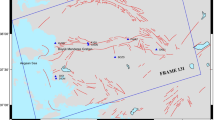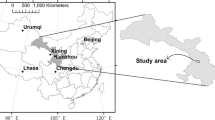Abstract
In the eastern part of the Gediz Graben, especially in the Sarıgöl region, surface deformations that occurred without destructive earthquakes or that continue to occur are frequently observed from the 1969 Alaşehir earthquake to the present. Especially in areas where aseismic and tectonic effects are thought to co-exist, such as the Gediz Graben, the general deformation character of the study area cannot be identified precisely from the surface deformations that are determined using the GNSS method as pointwise. However, the general deformation character of the study area can be identified clearly by determining the surface deformations of the study area with the PSInSAR method areally. In this study, in order to determine surface deformations that may be caused by aseismic and/or tectonic effects in the Gediz Graben areally, deformations in the direction of Line of Sight (LOS) were determined by using the persistent scatterer interferometric synthetic aperture radar (PSInSAR) method. In order to determine movements in the LOS direction, TERRASAR-X Stripmap satellite radar images of the German Aerospace Center (DLR) were used. According to the evaluations obtained from the PSInSAR results, it is understood that while there are subsidences in the graben area of the Gediz Graben, there are uplifts in the north and south of the graben. The subsidence values in the graben were obtained to be approximately − 50 mm/year. This result indicates that in addition to creep movement of tectonic origin in the study area, the local soil characteristics and/or seasonal groundwater changes may also increase deformation in areas where deformation occurs.





Similar content being viewed by others
References
Abdikan S, Arıkan M, Sanli FB (2014) Monitoring of coal mining subsidence in peri-urban area of Zonguldak city (NW Turkey) with persistent scatterer interferometry using ALOS-PALSAR. Environ Earth Sci 71:4081
Akyol N, Zhu L, Mitchell BJ, Sözbilir H, Kekovalı K (2006) Crustal structure and local seismicity in western Anatolia. Geophys J Int 166(3):1259–1269
Aktuğ B, Kılıçoğlu A (2006) Recent crustal deformation of ̇Izmir, Western Anatolia and surrounding regions as deduced from repeated GPS measurements and strain field. J Geodyn 41:471–484
Arikan M, Hooper A, Hanssen R (2010a) Radar time series analysis over West Anatolia. European Space Agency (Special Publication) ESA SP-677
Arikan M, Hooper A, Hanssen R (2010b) Radar time series analysis over west anatolia. In Proc. FRINGE workshop (pp. 1-6)
Arpat E, Bingöl E, (1969) Ege Graben sistemleri ve Batı Anadolu’nun genel tektoniği üzerinde düşünceler. MTA Yayını derleme no: 4172, 41 s
Ayhan E, Kasnak E, Öğütçü Z, Kalafat D, İnce Ş, Akkartal B, Püskülcü S, Özel N, Öz G, Sevimay K, Kara M, Pınar A (1989) 1976-1986 yılları arasında Batı Türkiye’de diri fay zonlarının ve depremlerin etkinliği. Deprem Araştırma Bülteni 64:5–191
Barka A, Akyüz S, Rockwell T, Tatar O, Gürsoy H, Temiz H, Emre Ö (1998) Kuzey Anadolu Fayının Gaziköy-Saroz Segmenti, Gediz Grabeni Salihli-Alaşehir ve İzmir Çevresi Aktif Fayları Üzerinde Paleosismik Çalışmalar [Paleoseismic studies on the Gaziköy-Saroz segment of the North Anatolian Fault and on the active faults of Salihli-Alaşehir and the vicinity of Izmir of the Gediz Graben]. YDABÇAG 434-G
Baysal D, Aktuğ B, Kılıçoğlu A (2010) GPS Nokta Koordinatlarındaki Zamana Bağlı Değişimlerin Analizi ve Yorumu: İzmir Bölgesinde Uygulama. Analysis and interpretation of temporal changes in gps coordinates: a case study in Izmir Region. Harita Dergisi Temmuz 2010 Sayı 144 (2010)
Bath M (1982) Seismic energy mapping applied to Turkey. Tectonophysics 82(1–2):69–87
Bozkurt E (2001) Neotectonics of Turkey–a synthesis. Geodin Acta 14(1–3):3–30
Cetin E, Cakir Z, Meghraoui M, Ergintav S, Akoglu AM (2014) Extent and distribution of aseismic slip on the Ismetpaşa segment of the North Anatolian Fault (Turkey) from persistent Scatterer InSAR. Geochem Geophys Geosyst 15(7):2883–2894
Colesenti C, Ferretti A, Prati C, Rocca F, (2001) Comparing GPS, optical leveling and persistent scatterers. Proceedings of IGARSS 2622–2624
Colesenti C, Ferretti A, Prati C, Rocca F (2003) Monitoring landslides and tectonic motions with permanent scatterers technique. Eng Geol 68:3–14
Çırmık A, Pamukçu O (2017) Clarifying the interplate main tectonic elements of Western Anatolia, Turkey by using GNSS velocities and Bouguer gravity anomalies. J Asian Earth Sci 148:294–304
Emre T (1996) Gediz grabeninin tektonik evrimi [Tectonic evolution of the Gediz graben]. Türk Jeol Bül 39(2):1–18
Emre Ö, Duman TY, Özalp S, Elmacı H, Olgun Ş, Şaroğlu F (2013) 1/1.125.000 Ölçekli Türkiye Diri Fay Haritası [1/1.125.000-Scale Turkey Active Fault Map], Maden Tetkik ve Arama Genel Müdürlüğü Özel Yayınlar Serisi-, Ankara, Türkiye
Eravcı B, Yaman M, Tepeuğur E, Erkmen C, Aktan T, Albayrak H, Demirtaş R (2007) Batı Anadolu Çöküntü Bölgesİ’nin Paleo Sİsmolojİ Projesı̇. The Paleoseismology project of the Western Anatolian subsidence region. DPT, 2002 K 120050
Erdoğan S, Sahin M, Tiryakioglu I, Gulal E, Telli AK (2009) GPS velocity and strain rate fields in Southwest Anatolia from repeated GPS measurements. Sensors 9(3):2017–2034
Ergin K, Gülü U, Aksay G (1971) A catalog of earthquakes of Turkey and surrounding area (1965–1970). Technical report, İstanbul Technical University, Faculty of Mines, Institute of Physics of the earth, no 28
Eyidoğan H (1988) Rates of crustal deformation in western Turkey as deduced from major earthquakes. Tectonophysics 148:83–92
Ferretti A, Prati C, Rocca F (2001) Permanent Scatterers in SAR interferometry. IEEE Trans Geosci Remote Sens 39(1):8–20
Gürsoy H, Temiz H, Tatar O (1997) Gediz Grabeni GD kenarındaki güncel deformasyon verileri. Aktif Tektonik Araştırma Grubu Birinci Toplantısı. İTÜ, İstanbul
Hastaoglu KO (2016) Comparing the results of PSInSAR and GNSS on slow motion landslides, Koyulhisar, Turkey. Geomatics. Nat Hazards Risk 7(2):786–803. https://doi.org/10.1080/19475705.2014.978822
Hernández-Madrigal VM, Muñiz-Jauregui JA, Garduño-Monroy VH, Flores-Lázaro N, Figueroa-Miranda S (2014) Depreciation factor equation to evaluate the economic losses from ground failure due to subsidence related to groundwater withdrawal. Nat Sci 6(3):108–113
Holzer TL (1980) Faulting caused by groundwater level declines, San Joaquin Valley, California. Water Resour Res 16(6):1065–1070
Hooper A, Zebker H, Segall P, Kampes B (2004) A new method for measuring deformation on volcanoes and other natural terrains using InSAR persistent scatterers. Geophys Res Lett 31(23):5. https://doi.org/10.1029/2004GL021737
Hooper A, Segall P, Zebker H (2007) Persistent Scatterer InSAR for crustal deformation analysis, with application to Volcán Alcedo. Galápagos J Geophys Res 112:B07407e. https://doi.org/10.1029/2006JB004763
Holzer TL (1984) Ground failure induced by groundwater withdrawal from unconsolidated sediment. In: Holzer Holzer TH (ed) Man- induced land subsidence, VI, Reviews in Engineering Geology. Geological Society of America, Colorado, pp 67–105
Khoshmanesh M, Shirzaei M, Nadeau RM (2015) Time-dependent model of aseismic slip on the central San Andreas Fault from InSAR time series and repeating earthquakes. J Geophys Res Solid Earth 120(9):6658–6679
Koca MY, Sözbilir H, Uzel B (2011) Sarıgöl fay zonu boyunca meydana gelen deformasyonların nedenleri üzerine bir araştırma An investigation of the causes of deformations occurring along the Sarıgöl fault zone. Jeoloji Mühendisliği Dergisi, 35 (2), 151–174
McClusky S, Aktuğ B, Aygül H, Baassanian S, Barka A, Burchfiel C, Çakmak R, Ergintav S, Hamburger M, Kahle H, Kastens K, King R, Kotzev V, Mahmoud S, Nadariya M, Özener H, Prilepin M, Reilinger R, Seeger H, Tari E, Türkezer A, Veis G (1999) GPS Constraints on active tectonics in the eastern mediterranean region. UNAVCO Meeting, Boulder CO., April 7–9
Meisina C, Zucca F, Fossati D, Ceriani M, Allievi J (2006) Ground deformation monitoring by using the permanent scatterers technique: the example of the Oltrepo Pavese (Lombardia, Italy). Eng Geol 88(3–4):240–259
Nyst M, Thatcher W (2004) New constraints on the active tectonic deformation of the Aegean. J Geophys Res 109:B11406. https://doi.org/10.1029/2003JB002830
Özener H, Doğru A, Acar M (2012) Determination of the displacements along the Tuzla fault (Aegean region-Turkey): preliminary results from GPS and precise leveling techniques. J Geodyn. https://doi.org/10.1016/j.jog.2012.06.001
Özkaymak Ç, Sözbilir H, Tiryakioğlu İ, Baybura T (2017) Bolvadin’de (Afyon-Akşehir Grabeni, Afyon) Gözlenen Yüzey Deformasyonlarının Jeolojik, Jeomorfolojik ve Jeodezik Analizi. Türkiye Jeoloji Bülteni/Geological Bulletin of Turkey 60(2):169–189
Perissin D, Rocca F (2006) High accuracy urban DEM using permanent scatterers. IEEE Trans Geosci Remote Sens 44(11):3338–3347
Peyret M, Rolandone F, Dominguez S, Djamour Y, Meyer B (2008) Source model for the Mw 6.1, 31 March 2006, Chalan–Chulan earthquake (Iran) from InSAR. Terra Nova 20(2):126–133
Pewe (1990) Land subsidence and earth-fissure formation caused by groundwater withdrawal in Arizona: a review. Groundwater Geomorphology The role of subsurface water in Earth-surface processes and Landforms, edited by Charles G. Higgins, Donald Robert Coates, Geological Society of America pub. p.252
Poyraz F, Hastaoğlu KO, Koçbulut Tİ, Tatar O, Demirel M, Duman H, Aydın C, Ciğer AF, Gursoy O, Turk T, Sıgırcı R (2019) Determination of the block movements in the eastern section of the Gediz Graben (Turkey) from GNSS measurements. J Geodyn 123(2019):38–48
Reilinger RE et al (2006) GPS constraints on continental deformation in the Africa Arabia- Eurasia continental collision zone and implications for the dynamics of plate interactions. J Geophys Res 111:B05411. https://doi.org/10.1029/2005JB004051
Seyitoğlu G, Scott BC (1996) The age of Alaşehir graben (west Turkey) and its tectonic implications. Geol J 31:1–11
Shirzaei M, Bürgmann R, Foster J, Walter TR, Brooks BA (2013) Aseismic deformation across the Hilina fault system, Hawaii, revealed by wavelet analysis of InSAR and GPS time series. Earth Planet Sci Lett 376:12–19
Şahin M, Erdoğan S, Güllü M, Baybura T, Tiryakioğlu İ, Erdogan O, Taktak F, Yavaşoğlu H, Karaman H, Erden T, Bilgi S, Ruzgar G, Tari E, Coskun Z, Tuysuz O (2007) Burdur Fethiye fay Zonu Tektonik Hareketlerinin GPS ile Belirlenmesi. Determination of the tectonic movements of the Burdur Fethiye Fault Zone with GPS. TÜBİTAK Projesi (104Y035)
Tiryakioğlu I (2015) Geodetic aspects of the 19 May 2011 Simav earthquake in Turkey. Geomat Nat Haz Risk 6(1):76–89
Van Siclen DC (1967) The Houston fault problem: Am. Inst. Prof. Geologists, Texas Sec. 3rd Ann. Mtg., Proc., Dallas, 9–31
Wasowski J, Ferretti A, Colesanti C (2007) Space-borne SAR interferometry for long term monitoring of slope instability hazards. In Proceedings of 1st North American Landslide Conference, Vail, Colorado, USA (pp. 3-8)
Yen JY, Lu CH, Chang CP, Hooper A, Chang YH, Liang WT, Chang TY, Lin MS, Chen KS (2011) Investigating active deformation in the northern longitudinal valley and City of Hualien in Eastern Taiwan using persistent scatterer and small-baseline SAR interferometry. Terr Atmos Ocean Sci 22(3):291–304
Acknowledgments
The data obtained within the scope of the project no. UDAP-Ç-13-07 supported by AFAD (Disaster and Emergency Management Authority) and the project no.113Y526 supported by TÜBİTAK (Scientific and Technological Research Council of Turkey) were used in the study. The authors are grateful to the German Aerospace Center (DLR) for providing TERRASAR-X data under GEO2307. GMT (Wessel and Smith 1998) software was used for the map drawings. Interferometric data were processed using the public domain SAR processor DORIS, StaMPS.
Author information
Authors and Affiliations
Corresponding author
Additional information
Responsible Editor: Biswajeet Pradhan
Rights and permissions
About this article
Cite this article
Poyraz, F., Hastaoğlu, K.Ö. Monitoring of tectonic movements of the Gediz Graben by the PSInSAR method and validation with GNSS results. Arab J Geosci 13, 844 (2020). https://doi.org/10.1007/s12517-020-05834-5
Received:
Accepted:
Published:
DOI: https://doi.org/10.1007/s12517-020-05834-5




